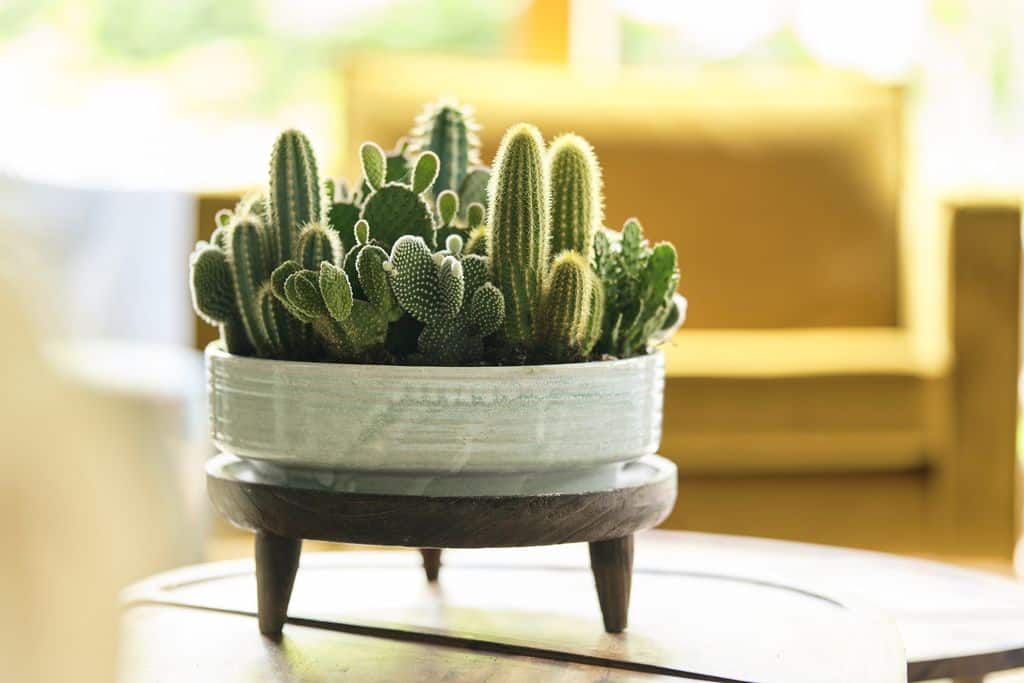
As you may have guessed from the title, we will be discussing the different types of cactus Plant for your home in this blog, but before we get to the best, let’s get the basics out of the way and understand what is cacti?
Cacti, known by its family name Cactaceae, is a very popular and common desert plant. The word “cactus” originates in Latin from the Greek word kàktos. The word was first used by Theophrastus to describe a plant with spines that have not been identified as of yet.
Cacti mostly live in humid conditions and habitats that are subjected to at least one drought. Many cacti live in dry regions like the Atacama desert, the driest point on Earth. They have thus acquired the ability to survive without water for a longer period of time.
Are All Cacti Succulents?
All cacti are succulents which means that they store water in their thick and fleshy parts, mostly in the stem. Cacti and succulents are interchangeable terms but they are not the same as all succulents are not cacti. The spines on the cactus are modified leaves that prevent water loss and assist in water retention. The areoles are the identifying factor of cacti. These are small bumps out which develop the spines. Areoles also give rise to multi-petaled and tubular flowers. Many succulents do not possess areoles which is why they are a different family altogether.
Cacti are normally thought of as desert plants but they can thrive in home environments too and can make a pretty cute decor. Here are some cacti that will make your home pop with some green and cuteness. They have been differentiated into indoor and outdoor cacti and have been named along with their scientific names just for your reference.
The Best Indoor Cacti
Cacti is synonymous with dry and arid environments but it can also be grown indoors. It can be an added piece of decor for your window sill or a side cupboard. Indoor cacti need less sunlight, are smaller in size, and are the perfect houseplant.
1. Bunny Ears Cacti (Opuntia microdasys)
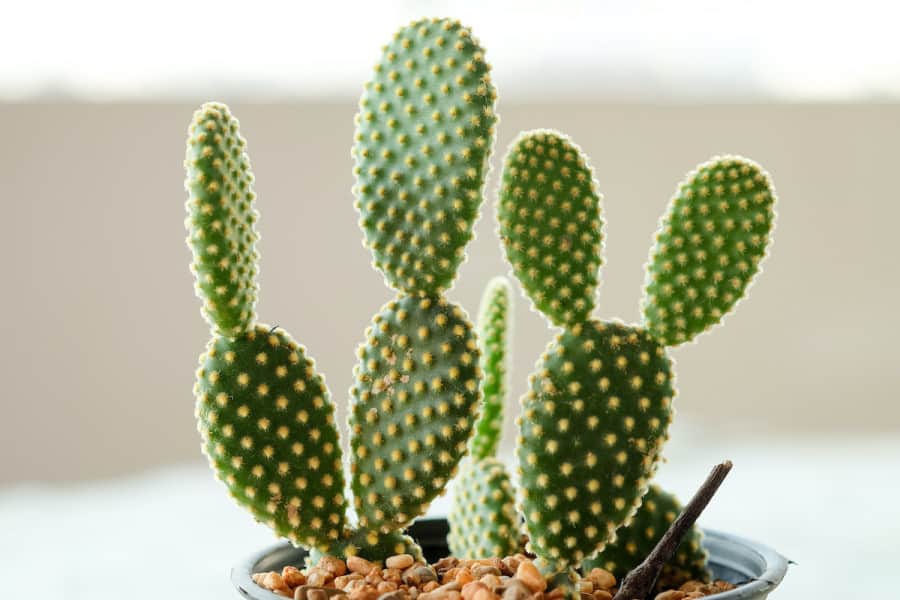
Opuntia microdasys are native to Mexico and their common name comes from their resemblance to bunny ears. Bunny ears cacti have two pads that are shaped like the ears of the bunny. The entire cactus is covered with brown prickles, otherwise called glochids. Thus, it should be handled with care when making it a houseplant. It grows up to 2 to 3 feet and produces white flowers and purple fruits making it the prettiest picture in your house.
Soil: 40 percent sand, 40 percent potting soil, 20 percent moss
Sunlight: Direct sunlight
Water: Every 3 to 4 weeks during fall and winter, fertilize with cactus formula or diluted houseplant food every spring and summer.
2. Chin Cactus (Gymnocalycium)
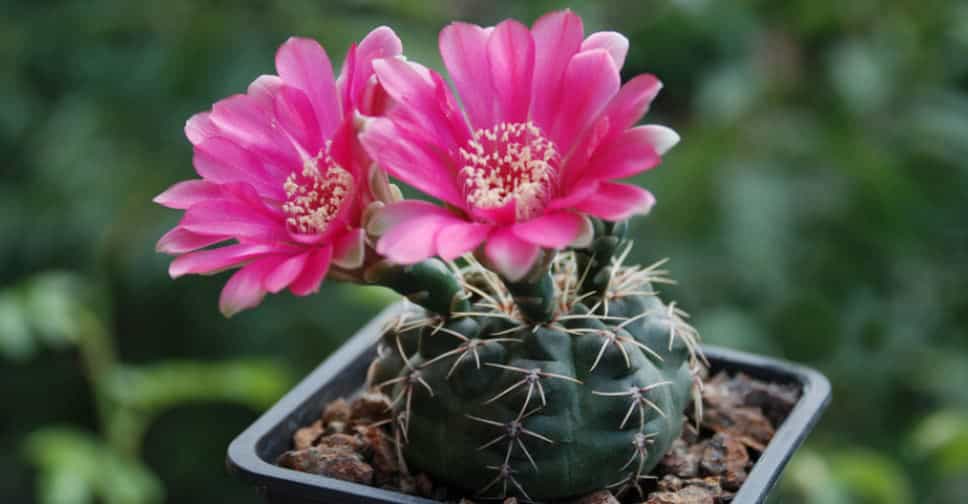
The South American species of cactus’ name means “naked kalyx” in Greek. It refers to the absence of hair or spines on the flower bud. Gymnocalycium is popularly called chin cactus and they come in different varieties; depending upon which some seek shade while others thrive in bright sunlight.
Soil: Well draining, gritty cactus soil
Sunlight: Indirect bright sunlight
Water: Once every week in summer, leave it dry in winters.
3. Saguaro Cactus (Carnegiea gigantea)
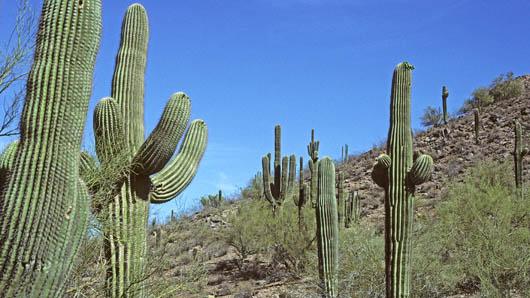
The saguaro cactus can be treated both as an indoor cactus as well as an outdoor cactus. It grows up to 40 feet for years which means while it’s growing it can be an indoor plant and must be relocated outdoors when it can no longer be kept inside. The body of this cactus is barrel-shaped, i.e., the classic cactus appearance. This type of cactus is native to the Sonoran desert and requires a lot of sunlight. So remember to place it in an area with maximum sunlight while indoors.
Soil: Well-drained compost (add grit to John Innes compost), loamy soil
Sunlight: Direct sunlight
Water: Water only certain times in a year.
4. Old Lady Cactus (Mammillaria hahniana)
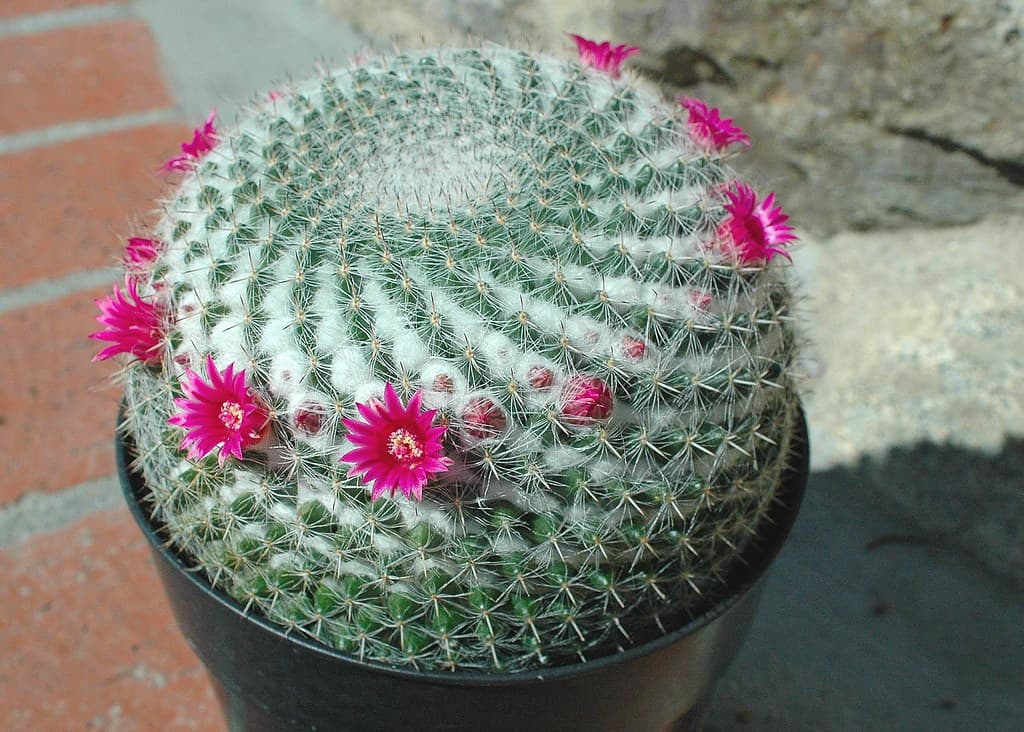
Old lady cactus is of the Mammillaria family with a pin cushion resemblance. It’s filled with hairs and spines and a halo of tiny pink and/or purple flowers. Remember to make a sandy mix for potting this plant and to water it every other week.
Soil: Combine, cactus soil mixes with part perlite or coarse sand, feed once a month with potassium fertilizer. It requires fast-draining soil.
Sunlight: 4 to 6 hours of direct sunlight
Water: In sunny areas, it’ll need water once a week. In semi-shaded areas, it’ll need water once every two weeks.
5. Star Cactus (Astrophytum asteria)
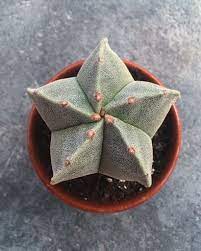
A star cactus is also known as sand dollar cactus or sea urchin cactus. It has a round body and 8 sectionings with tiny white hairs and dots all over it. It blooms yellow flowers during spring and grows 2 to 6 inches in diameter. This cutie will make the perfect house plant.
Soil: Well-draining, sandy potting soil.
Sunlight: Direct sunlight
Water: Sparse watering with water not getting accumulated in the soil as it could rot the roots.
6. Easter Cactus (Hatiora gaertneri)
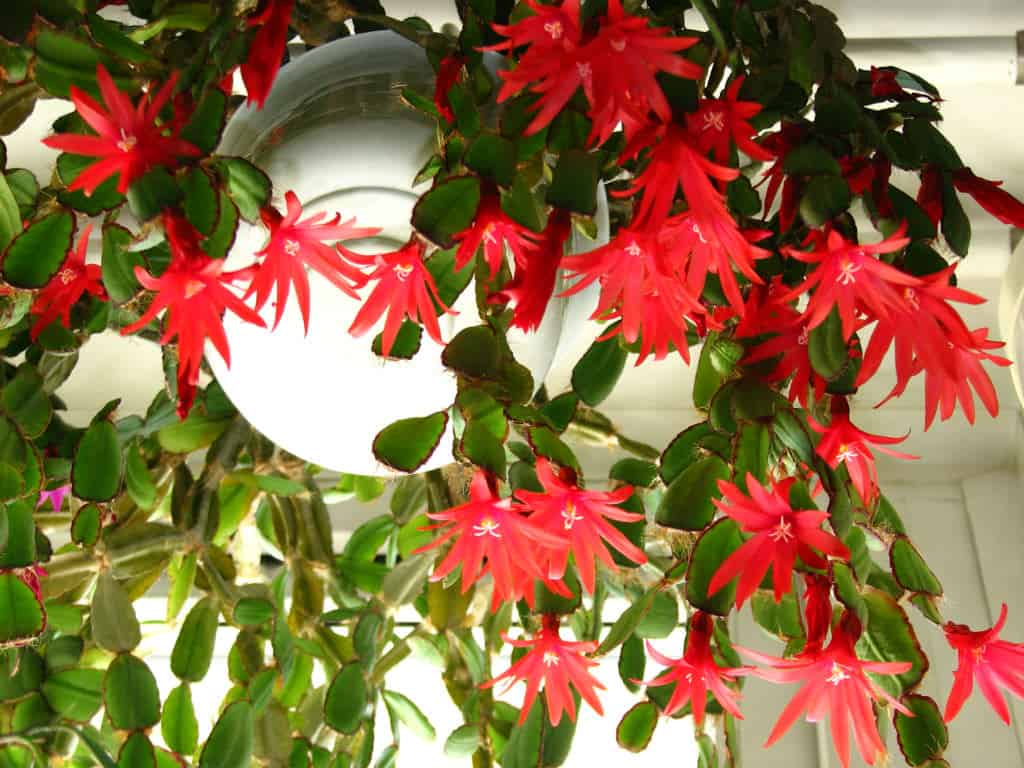
Hatiora gaertneri is a native to Brazil that blooms in late winters and early spring. It is also called Schlumbergera gaertneri and is one assortment of colors with its flowers varying from lavenders to whites to oranges. The spines are stacked on top of each other giving it a unique look. It requires a decent amount of sunlight but is not direct as it might burn the fleshy leaves. It would add a colored edge to your plant corner.
Soil: Porous soil with good airflow to the roots and rich in organic matter. Mix peat moss, coco coir, orchid bark, and perlite for the ideal mix. Amend the soil regularly with compost or organic fertilizers to keep the richness of nutrients.
Sunlight: Bright indirect sunlight.
Water: Ensure no waterlogging. Water only after the soil has dried out after each watering. From fall to early winter waterless to encourage blooming.
7. Christmas Cactus (Schlumbergera bridgesii)
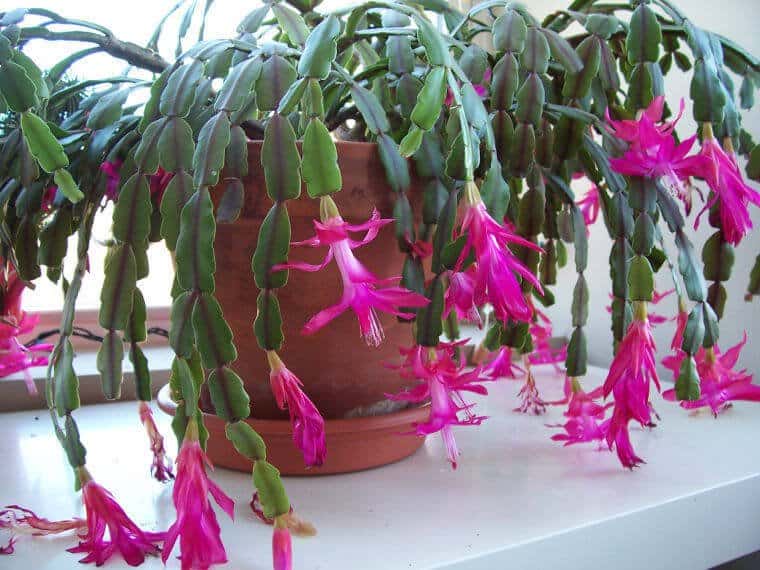
Schlumbergera bridgesii blooms in late winters with vibrant red colors under sunlight making it the perfect holiday gift. In moderate home conditions, Christmas Cactus will thrive well. The plant is adaptable as low light plants too and requires very less amount of water. Too much water can rot its roots.
Soil: Peat or well-decomposed compost with added coarse sand, or aquarium gravel to provide required drainage and aeration.
Sunlight: Bright, indirect sunlight
Water: It requires water every 2 to 3 weeks. From spring to early fall, water every 2 weeks.
8. Moon Cactus (Gymnocalycium mihanovichii)
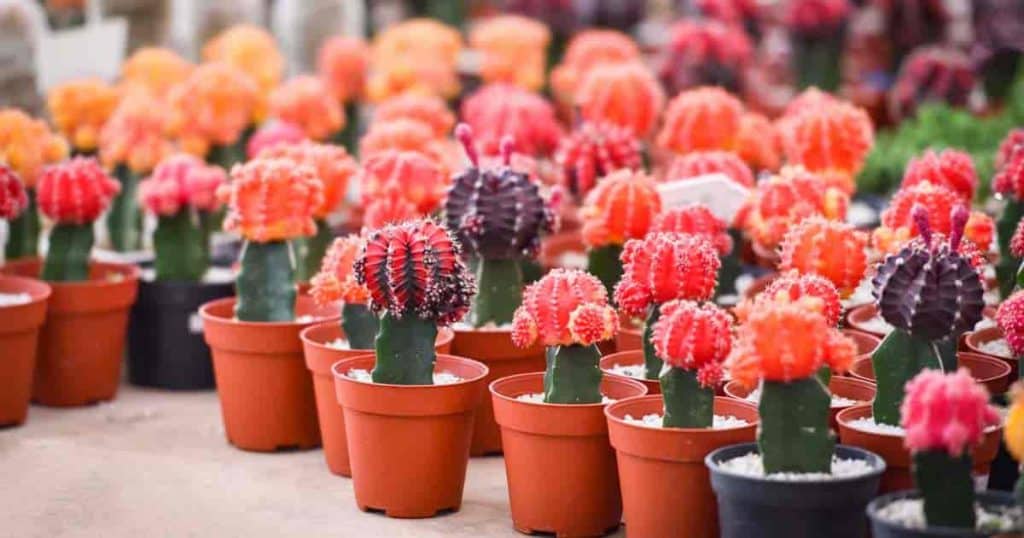
This type of cactus varies in shape, size, and color. Among its varied types, the hibotan cactus is popular. It originates in South America and blooms bright Reds, oranges, pinks, and yellows. It can thrive on partially lighted spaces and will add a splash of colors to it.
Soil: Potting soil mix, perlite, coarse sand
Sunlight: Partial, indirect sunlight
Water: It should be watered during the growing season and not in the winter months. Alos. water once thoroughly and wait for it to dry out completely before watering again.
9. Feather Cactus (Mammillaria plumosa)
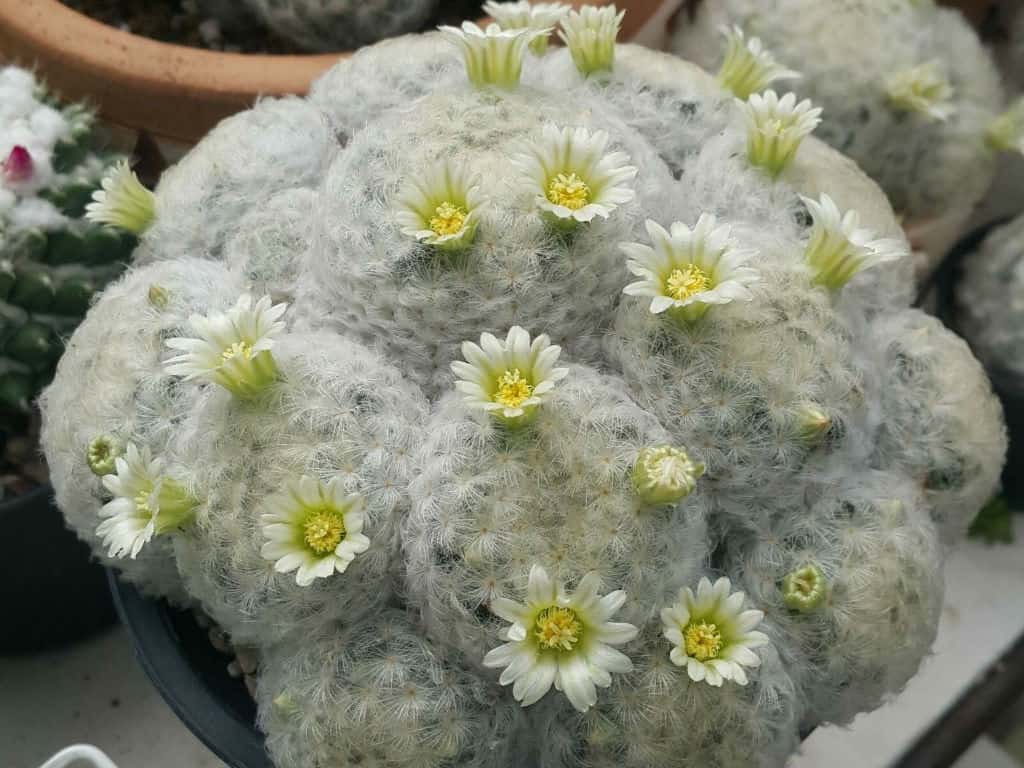
The feather cactus is identified by a fluffy feathery layer on top of it. Do not be fooled though as it hides a sharp spine that could prick you. It can grow up to 12 cm in height and 40 cm in diameter. It requires regular watering but it’s better to keep the water off the spiny feathers.
Soil: Sand and potting mix
Sunlight: 6 hours of direct sunlight during the day and partial sunlight during afternoons
Water: Once every 2 to 6 weeks
10. Lady Finger Cactus (Mammillaria elongata)
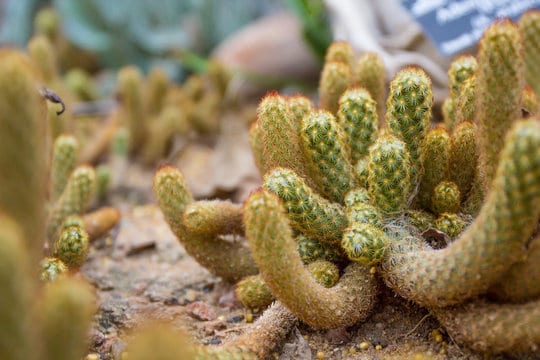
The Mammillaria elongata is also called the gold lace cactus. It grows up to 6 inches in height and blooms white flowers. This would be a subtle addition to your plant corner.
Soil: Rich, fast-draining soil
Sunlight: 4 hours of direct sunlight
Water: 0.8 cups of water every 12 days
11. Parodia (a genus)
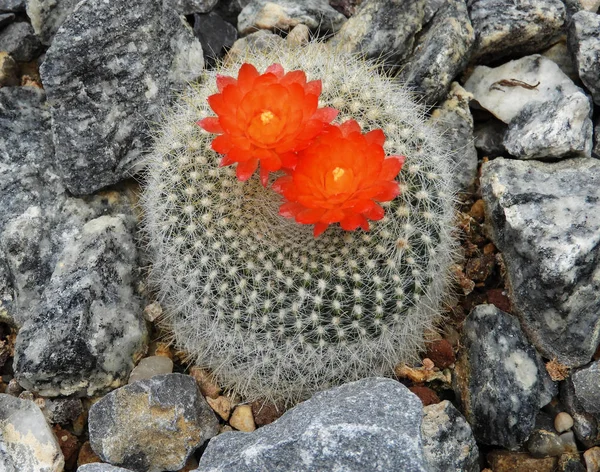
Parodia is a genus of the family Cactaceae which is native to the uplands of Peru, Argentina, Bolivia, Uruguay, Columbia, and Brazil. They range from a small globose plant to a 3 feet tall columnar plant. Thus, it can be placed outdoors or indoors depending upon the variety chosen. It requires less sunlight and more water than others.
Soil: Moist, well-drained, hydrated soil
Sunlight: Indirect sunlight
Water: Intermittent watering during spring and summer, less watering during winters.
12. Bishop’s Cap Cactus (Astrophytum myriostigma)
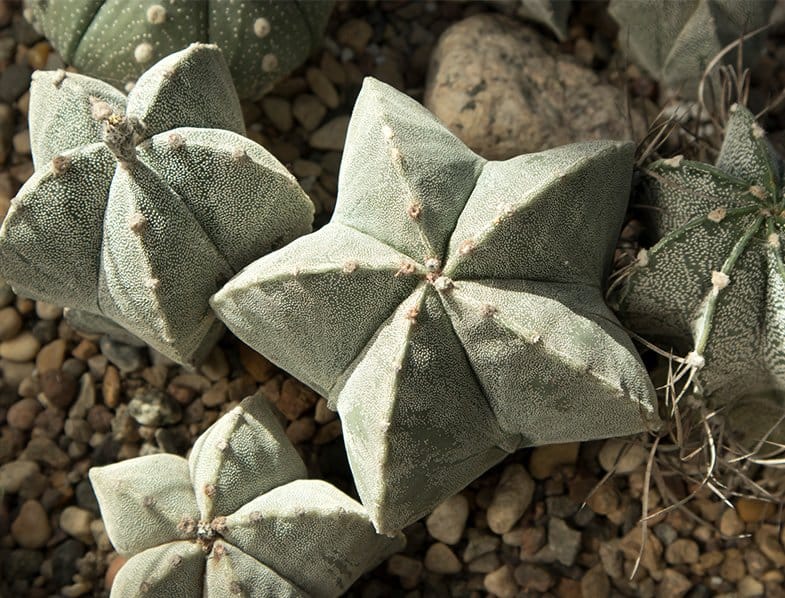
Bishop’s cap cactus also called Bishop’s miter cactus or Bishop’s hat cactus is native to the highlands of central and northeastern Mexico. It features a short blooming yellow flower and requires little water and space.
Soil: 25 percent coarse sand, 25 percent pumice
Sunlight: Direct sunlight but under the shade
Water: Moderate water in spring and summer, completely dry in fall and winter.
The Best Outdoor Cacti
The word cactus typically reminds you of long dry deserts with no signs of water. However, these dry plants can grow even in your backyards, requiring significantly less amount of water and care. Depending on your climate conditions, cacti can thrive as the perfect addition to your plant collection.
1. Barrel Cactus (Ferocactus)
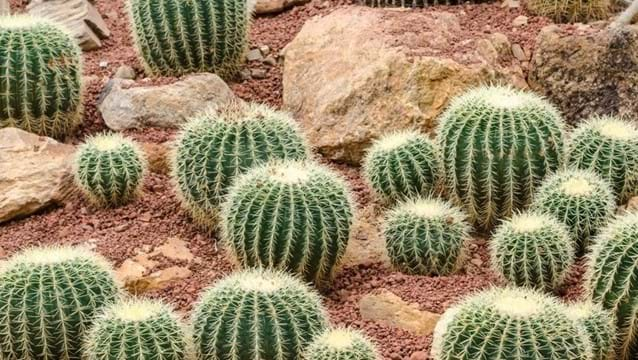
The barrel cactus is named after its circular or barrel shape. The sides of the plant are lined with ribs and spines. Some of the most popular varieties are California barrel, golden barrel, colviller’s barrel, blue barrel, and fishhook cactus. It blooms in the month of May and June in the colors red and yellow.
Soil: sand with a tad bit of topsoil, compost, and perlite
Sunlight: Bright indirect sunlight
Water: Water once every week in summer, once in 3 months in winters, and adequate water in spring.
2. Thanksgiving Cactus (Schlumbergera truncata)
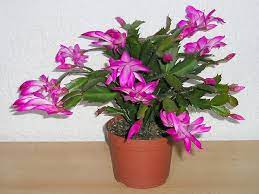
Schlumbergera truncata is also called crab cactus and blooms around the time of the holidays. It continues to bloom into the winters and prefers colder temperatures to thrive but remember to keep it from frosting.
Soil: well-drained soil (60 to 80 percent potting soil with 40 to 20 percent perlite)
Sunlight: Direct sunlight during fall and winter, indirect sunlight in summers
Water: It should never be waterlogged. 1 to 2 inches of soil should be dry before watering.
3. Queen Of The Night (Epiphyllum oxypetalum)
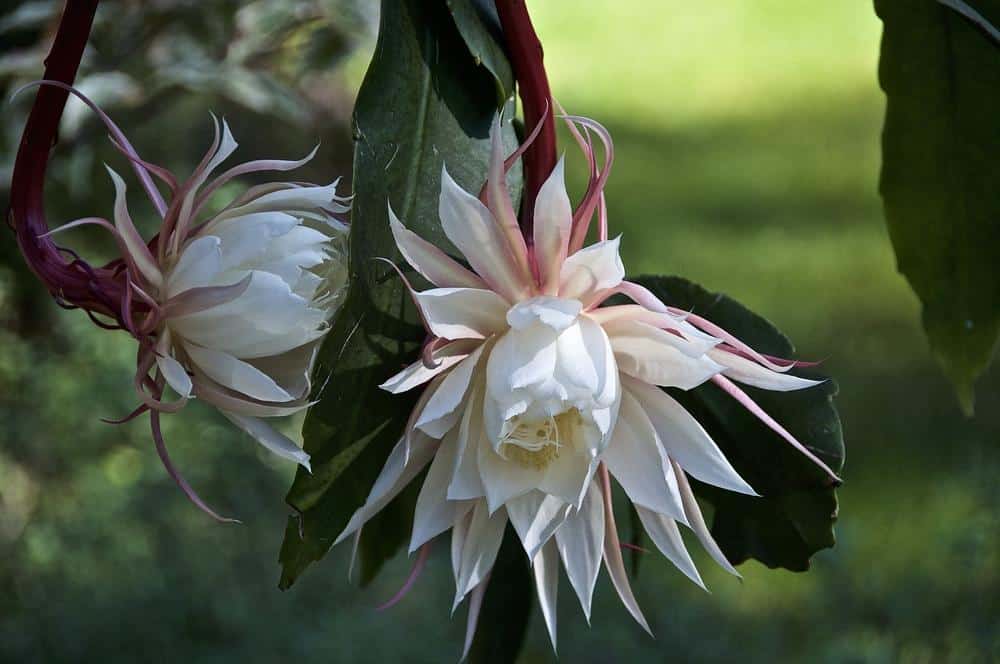
It is also called the dutchman’s pipe cactus and is an epiphyllum that grows on trees. Queen of the night is a type of cactus that is native to Brazil. It blooms white flowers at night and hence gets its name.
Soil: Slightly acidic soil (pH between 5.5 to 6.5)
Sunlight: Almost zero
Water: Water once every 2 weeks from spring to fall
4. Prickly Pear Cactus (Opuntia)
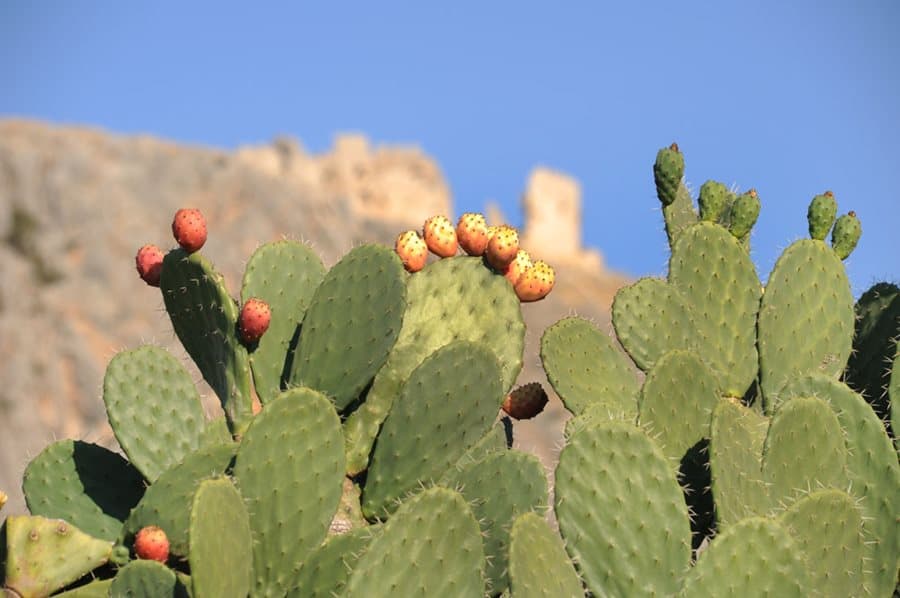
The prickly pear cactus are plants that are found in drought-prone regions. Some common variations of this type of cactus are Indian fig prickly pear cactus and beavertail prickly pear cactus. The unique feature of this cactus is that it sheds its spines which may not be for everyone. It has red, yellow, or purple blooms.
Soil: Dy, well-draining, and sandy or gravelly soil
Sunlight: 6 hours of direct sunlight
Water: 2 to 4 weeks for the 1st year, twice a month in summers, and once a month at other times of the year.
5. Cholla Cactus (Cylindropuntia fulgida)
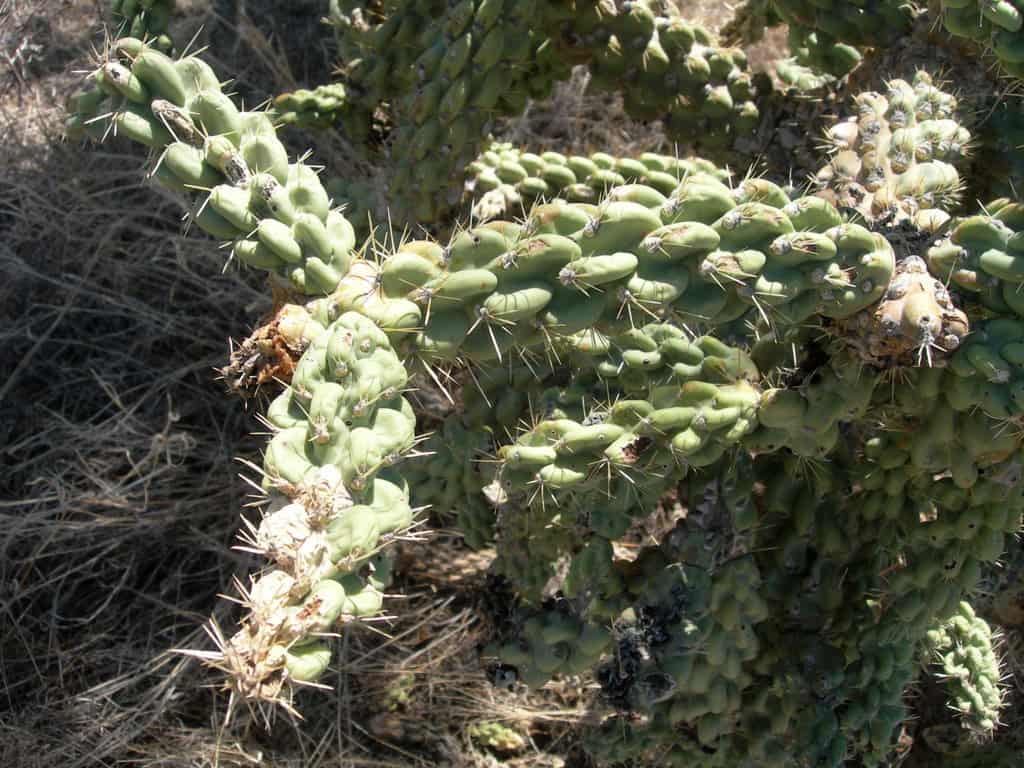
Cholla cactus is native to Southwest America and features a round stem with sharp spines. There are more than 20 species in the family with a wide variety of sizes. Their flowers are green or orange in color. It also requires less water than the other types of cacti.
Soil: Well-drained soil with ample grit
Sunlight: Direct sunlight
Water: 1 inch of water every month
6. Totem Pole Cactus (Pachycereus schottii monstrosus)
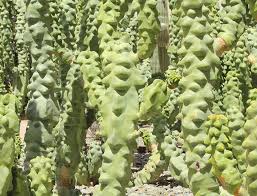
This type of cactus gets its name from its tall height resembling a totem pole. It’s around 10 to 12 feet in height and texture with wrinkles.
Soil: Soft and sandy gravelly soil
Sunlight: Indirect sunlight as too many rays can burn the plant.
Water: 10 to 14 days during summers
7. Fairy Castle Cactus (Acanthocereus tetragonus)
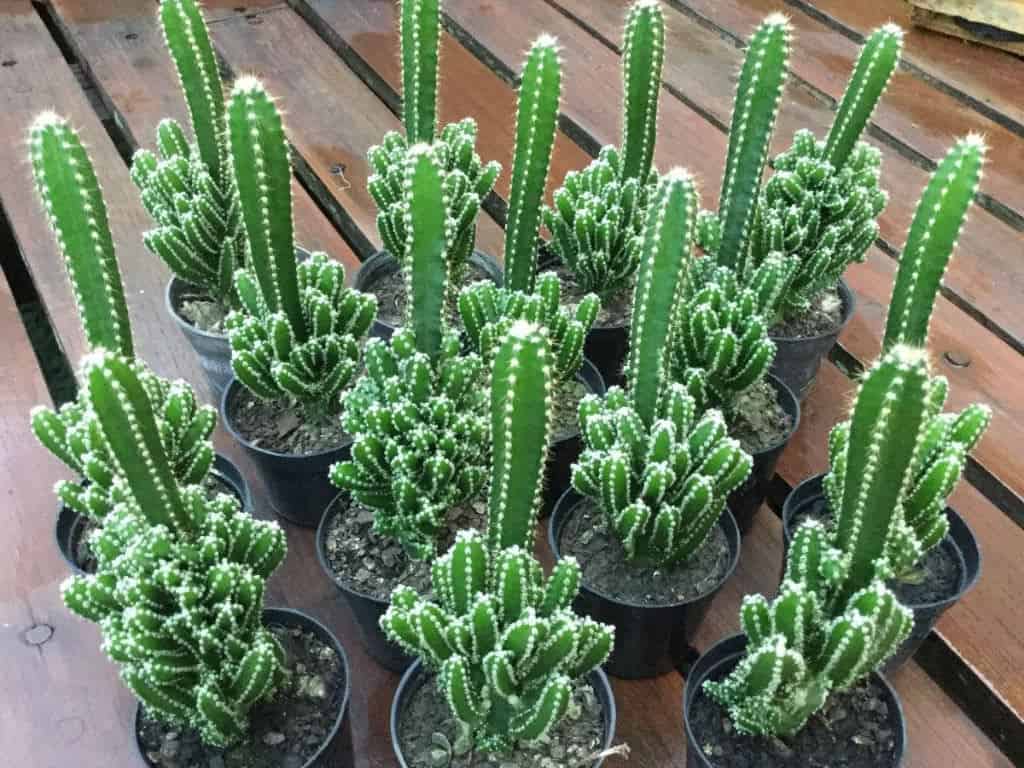
The name comes from its resemblance to the turrets of a castle with its varied stems. This is a slow-growing cactus that can reach up to 6 feet in height and rarely produces flowers. If you find flowers in it, note that those are artificial ones.
Soil: Well-draining soil (gravel, sand, bark, or perlite)
Sunlight: Direct sunlight
Water: Once every week
8. Blue Columnar Cactus (Pilosocereus pachycladus)
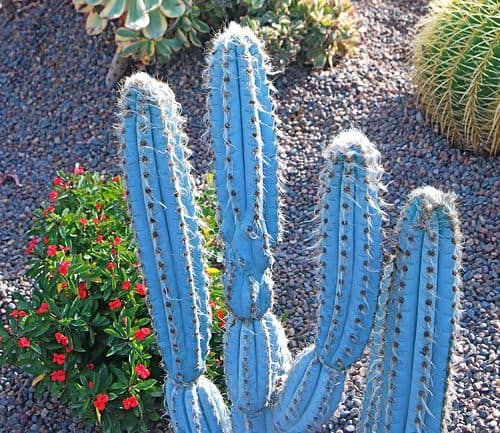
This type of cactus grows up to 30 feet in height and boasts funnel-shaped blooms.
Soil: Well-draining sandy soil with organic materials
Sunlight: Direct sunlight
Water: During spring and summer, water once a week or more frequently.
The Bottom Line
Here we come to the end of a long list of cacti for your plant corner. Some are indoor and outdoor plants but all are wonderful and unique in their own ways. Some might grace your garden while others your living room or window sill. All cacti are cute things that can add a pop to their surroundings with their bloom. If you don’t want to know or think it’s a hassle to grow plants, try growing a cactus.
Types Of Cactus FAQs:
1. How do I identify a cactus?
A cactus can be identified by the position of its flowers. Some flowers bloom at the plant’s apex while others bloom on the barks or stems.
Other flowers like the ones on chin cactus are naked as they are with no bristles, spines, or wool.
2. Is Aloe a cactus?
Aloe just resembles a cactus but it is taxonomically a member of the Asphodelaceae family, not the cacti family.
3. What cactus is edible?
The fruits of all cacti can be safely eaten. Some varieties of cacti such as the cholla cactus, dragon fruit cactus, and prickly pear cactus can be consumed as edible vegetables after removing their spines. However, there are also toxic cactus such as peyote, San Pedro cactus, and Bolivian cactus which should be avoided.
4. Which cactus is poisonous?
San Pedro cactus, Peyote, Saguaro cactus, Cholla cactus, Euphorbia canariensis, Barrel cactus, Echinopsis Peruviana, and Prickly pear are the most poisonous cacti.






